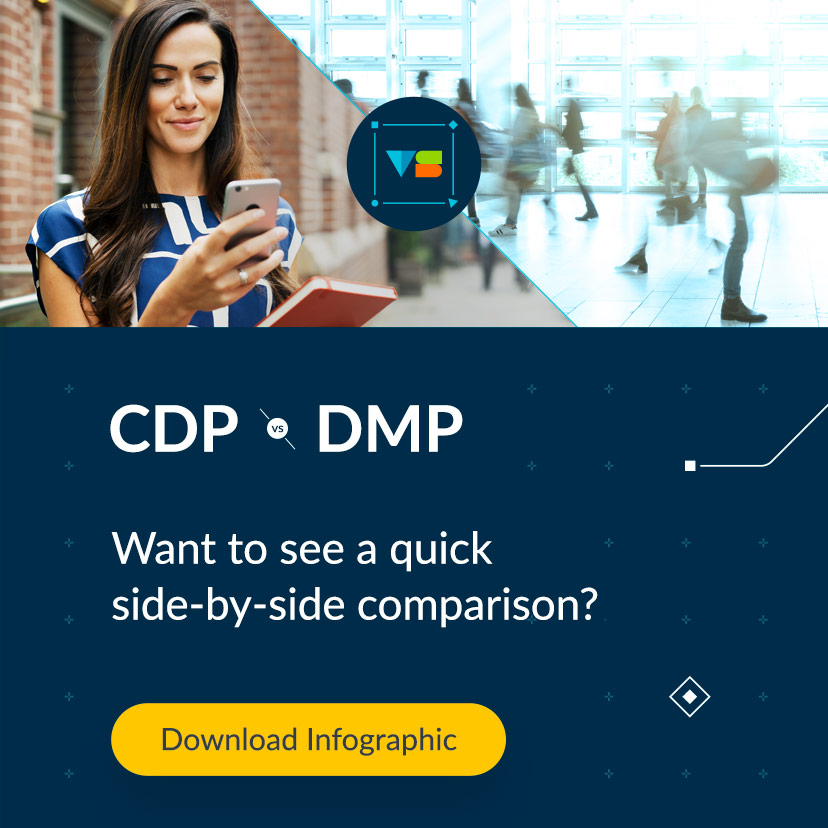PELAJARI
CDP vs. DMP: Apa perbedaannya?
Customer Data Platform (CDP) dan Data Management Platform (DMP atau Platform Manajemen Data) dapat saling melengkapi.
A CDP makes integration of 1st party data easier for DMPs to improve ad targeting, and a DMP enriches CDP data for smarter customer communication. DMPs primarily focus on 3rd party data, whereas CDPs make use of all data, including 1st party data. CDPs are focused on all aspects of marketing, whereas DMPs are designed specifically for advertisers and agencies to improve ad targeting.
DMPs alone won’t give you sustainable competitive advantage over your competitors. The whole purpose of DMPs is to help marketers understand their audience better so that they can target their ads better. DMPs are ultimately in the business of packaging and repackaging data. In general, their audiences get more accurate over time because they get to collect more anonymous data as their customers use the audiences they create on the DMP to run digital advertising.
The downside is that:
DMPs can’t store PII (Personally Identifiable Information)
For obvious reasons, since DMPs are in the business of sharing audiences.
DMPs can’t help their customers differentiate
A DMP is inherently an equalizer, not a differentiator, and while they are excellent at complementing your customer data (so that you can find out more about who your customers are), the same information can be retrieved by your competitor and all other customers of the DMP.
Learn more about Treasure Data CDP, a best-in-class customer data platform and central repository where all of your first-party data, website, mobile app, analytics tool, CRM, marketing automation, advertising channel, IoT, POS and other data is unified, made easily accessible into a single, reliable source of truth owned by your marketing team and available to all your business units.
CDP vs DMP
Berikut bagaimana CDP Institute mendefinisikan perbedaan antara DMP dan CDP:
“CDP bekerja sama dengan individu yang diketahui maupun anonim, menyimpan informasi identitas pribadi seperti nama, alamat surat-menyurat, alamat email, dan nomor telepon, sementara DMP bekerja sama hampir secara eksklusif dengan entitas anonim seperti cookie, perangkat, dan alamat IP. Anonimitas memang penting dalam peran DMP sebagai cara untuk bertukar informasi tentang audiens tanpa melanggar privasi pribadi. Yang berubah adalah CDP berintegrasi lebih sering dengan sistem iklan, dan oleh karena itu menyimpan lebih banyak informasi jenis DMP seperti ID cookie dengan tag audiens. Beberapa DMP juga menyimpan identitas pribadi, meskipun ini diisolasi dengan cermat dari situasi yang masih mementingkan anonimitas. Namun, hanya menambahkan identitas pribadi tidak memberi DMP kecocokan identitas lanjutan dan penyimpanan data fleksibel terintegrasi ke CDP. Jadi, akan sulit bagi sebagian besar DMP untuk mencocokkan sepenuhnya fungsi CDP.”
CDP
- Kasus Penggunaan Seluruh marketing, pengalaman pelanggan yang dipersonalisasi, serta layanan. Terintegrasi dengan sistem apa pun, termasuk adtech.
- Jenis data Manajemen data pihak pertama dengan pengayaan data pihak kedua dan ketiga.
- ID Berbasis kunci data pelanggan berwujud (PII): id pelanggan, nama, email, alamat atau kombinasinya
- Retensi data Jangka panjang, selama umur pelanggan.
DMP
- Kasus Penggunaan Khusus untuk periklanan, iklan bertarget, dan pembelian media yang efisien.
- Jenis data Manajemen data pihak ketiga dengan pengayaan data pihak pertama yang anonim.
- ID Berbasis ID digital non-PII anonim: cookie, IDFA, dsb.
- Retensi data Jangka pendek, selama periode campaign.
To learn more, read CDP vs. CRM: What’s the difference?
5 Reasons to Choose a CDP Over a DMP
Storing 1st Party Data, Including PII (Personally Identifiable Information)
Use Case: Customer Identity Matching
CDP
- Stores all 1st, 2nd and 3rd party data, including anonymous and PII data (such as individual customer names, postal addresses, emails, phone numbers). CDPs are integrated with advertising systems, and can store DMP-type information such as cookie IDs with audience tags.
DMP
- DMPs cannot accept 1st party data and work almost exclusively with anonymous information such as cookies, devices, IP addresses. Anonymity is essential to the DMP’s role as a way to exchange information about audiences without violating personal privacy. Some DMPs are also storing personal identifiers, but just adding personal identifiers doesn’t give a DMP the advanced identity matching built into CDPs.
Single, Unified Data Storage
Use Case: Flexible, Fast Querying
CDP
- CDP data is stored in a single, scalable place, making it fast and flexible to read through and analyze all the data at once.
DMP
- DMP has two different data stores – one for all the data and one for really fast utilization of a subset of that data, but living separately.
Raw, Detailed Data with Unlimited Storage Capacity
Use case: In-depth, rich analysis
CDP
- CDP captures raw data with granular level detail, and stores this historical information with unlimited capacity. Data is also collected for persistent, long-term storage and multiple data formats are supported, without predefined taxonomies.
DMP
- DMPs collect data like common transactional marketing tools – with tags, APIs, and uploads so often the resulting view is high-level and in aggregate. As such, most DMPs and transactional tools only retain user information for less than 90 days.
Applications in the Entire Martech Stack
Use Case: Usage Beyond Advertising
CDP
- CDP can take any data and get it wherever it needs to get – regardless of where in the customer life cycle (or marketing org) the other systems live. They can syndicate data to any kind of partner on either side of the known/anonymous equation – adtech or martech. That can mean passing segments of rich first party data onto Facebook for look-alike modeling or more effective retargeting and other steps in the customer journey.
DMP
- DMPs were designed to build targets for advertising and acquisition marketing, or dealing with new and unknown customers. They can be thought of as a cookie-pool with pre-built anonymous audiences to enhance display ad targeting. DMPs can’t help their customers differentiate: DMP is inherently an equalizer, not a differentiator, and while they are excellent at complementing your customer data (so that you can find out more about who they are), the same information can be retrieved by your competitor who happens to be the DMP’s customer.
Complete Customer Profile
Use Case: Personalized Customer Experience
CDP
- CDP allows you to have all the information about a person – historical, contextual, demographic, behavioral, etc. – on hand to inform the communication and brand interaction on a personalized basis. The persistence of the customer’s individual profile across all channels and sessions reveals a wealth of new traits and opportunities for personalization.
DMP
- DMP user profiles are basically a list of users and an associated list of which predefined categories/subcategories they belong to. DMP builds a temporary profile based on demographic information, anonymous cookie IDs and packaged and repackaged data from one customer to another. They cannot de-anonymize because of legal limitations related to sharing third party data and do not build a persistent user profile or help to resolve from an anonymous user to a known identity. Also, DMP decision making is often hidden inside a “black box” of predefined rules. Their audiences get more accurate over time.
Bicara dengan para pakar kami
Kami memahami bahwa tidak ada dua perusahaan yang sama pengoperasiannya. Tim layanan profesional kami dapat membantu Anda dalam menemukan solusi mandiri yang sesuai dengan anggaran Anda. Staf dukungan teknis kami yang sangat berdedikasi selalu siap membantu Anda.

